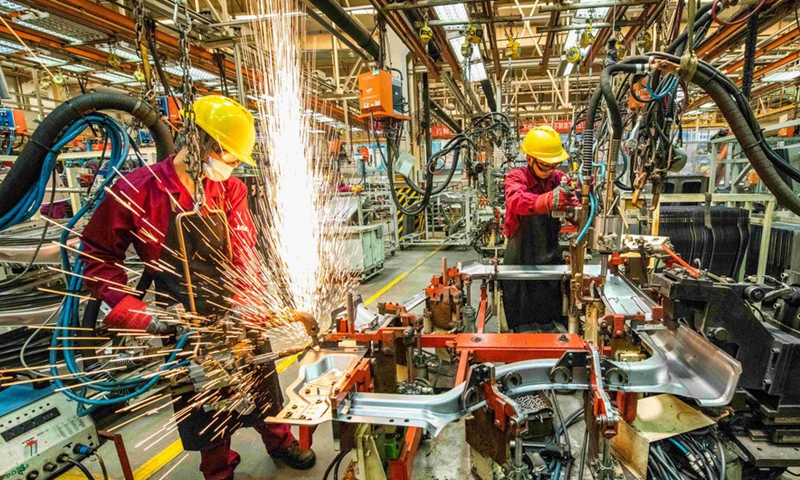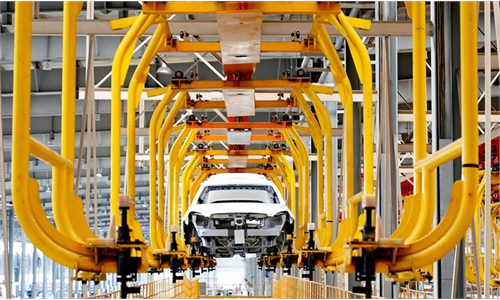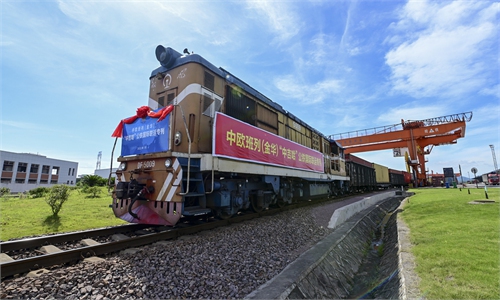China’s economic indicators beat forecast in August, ‘hard-won’ result indicating strong resilience, stimulus works: observers
Nation withstands coronavirus, heatwaves impact

Workers weld at a workshop of an automobile manufacturing enterprise in Qingzhou City, east China's Shandong Province.File Photo:Xinhua
China released its main economic indicators for August on Friday, recording better-than-expected growth and maintaining momentum from July, as government stimulus keeps the world's second-largest economy on track for a steady recovery despite strong headwinds linked to heat waves and sporadic COVID-19 flare-ups.
The positive growth is especially "hard-won," indicating a strong resilience and vast potential of the Chinese economy, officials and observers said on Friday, while warning about uncertainties and an unsolid recovery base with a complex situation at home and abroad.
Retail sales grew by 5.4 percent in August from a year earlier, up from a growth of 2.7 percent in July, the National Bureau of Statistics (NBS) said on Friday.
The growth rate is also higher than market expectation of 3.2 percent.
Industrial profits rose by 4.2 percent in August, up from the 3.8 percent rate in July. Fixed-asset investment for the first eight months of the year increased by 5.8 percent from a year earlier, a slight rise from the 5.7 percent growth in January to July.
The unemployment rate came in at 5.3 percent in August, 0.1 percentage points lower than in July.
In general, in August, the national economy withstood the impact of various unexpected factors and continued to recover and develop, with positive changes across major indicators, the NBS said in a statement on Friday.
The better-than-expected growth comes as China's economy has remained under pressure due in part to COVID control and prevention measures, extremely high temperatures in parts of China also resulted in temporary power rationing in some regions and shutdowns of factories.
The results are "hard-won," showing the Chinese economy is characterized by strong resilience, great potential, and wide space, NBS spokesperson Fu Linghui said.
Fu said the momentum is driven by the rapid economic recovery of the large Eastern provinces in August, and key industries such as automobiles and equipment manufacturing also push up the growth.
Key provinces and cities in East China including Zhejiang, Jiangsu, Shandong are also among the six provinces that have been assigned by the central government a task of taking the lead in supporting the country's growth in mid-August.
Chinese Premier Li Keqiang has called on six provinces of Guangdong, Jiangsu, Zhejiang, Shandong, Henan and Sichuan - accounting for a roughly 40 percent of China's GDP - to take the lead in supporting the country's growth after data for July showed a slowdown.
A lead of recovery in these provinces will play a crucial role in revitalizing and stabilizing Chinese economy, since "They are either export-oriented or provinces with great labor export or key industries, vital to the job market," Li Changan, a professor at the Academy of China Open Economy Studies of the International Business and Economics, told the Global Times on Friday.
For instance, China's export engine Guangdong, reported exports totaled 3.34 trillion yuan ($475.6 billion) in the first eight months of the year, a year-on-year increase of 4.9 percent, customs data showed on Friday.
Other provinces, including Zhejiang and Jiangsu have been organizing working teams to local cities to visit firms, hold face-to-face talks, to mull for more stimulus policies.
"The faster growth in August is a result of the implementation of a slew of pro-growth measures, and they are indeed working and pushing our economy on fast track of recovery," Li said.
The State Council, China's cabinet, has assigned task forces headed by ministers to some major economic provinces to oversee local implementation of wide-ranging policies to stabilize the economy.
The NBS said it will "aggressively push" the implementation of a package of economic stabilizing policy measures and follow-up policies to achieve results, focus on expanding effective demand, stabilizing employment and prices, consolidate the foundation for economic recovery, and keep the economy operating within a reasonable range.
The Chinese government has unveiled a series of stimulus measures to prop up growth and ease the financial burden on enterprises, with frequent meetings and signals over the past several months.
The State Council in August unveiled 19 policy measures specifically aimed at various economic challenges such as extreme weather and the troubled housing market, which have been interpreted as China's pro-stabilization policy package 2.0 in addition to 33 pro-growth measures that came in late May.
On the consumption end, authorities have been organizing consumption exhibitions and handing out vouchers to bolster consumer spending during the traditional peak season of September and October.
With stimulus policies taking effect, consumption in the past two months has actually shown signs of recovery. As long as this positive momentum can be sustained, growth will continue. There is no need to worry, Hu Qimu, chief research fellow at the Sinosteel Economic Research Institute, told the Global Times Friday.
Incentives in the auto sector have been particularly strong, which prompted sales of passenger cars in China to rise 28.9 percent year-on-year in August - the most in a decade - driven by a surge in demand for electric vehicles.
Li said the strong growth in the new-energy sector is playing an increasingly leading role in driving growth, "replacing some of the role of the real-estate sector in Chinese national economy," and calling for more policy support.
Moreover, Hu said that China's advanced manufacturing supply and industrial chains are resilient enough to withstand skyrocketing global commodity and energy prices.
Export momentum is also expected to remain strong. "Under the current pressure of overseas stagflation and the epidemic, the industrial chains of various countries have been affected, and orders are likely to return to China, further backing China's economic recovery," Hu said.
Amid challenges at both home and abroad, Hu said to improve market sentiment is particularly important at the moment, advising the authorities to provide "stronger signals and policies" in an effort to push up market confidence.




